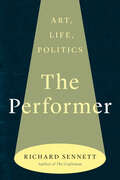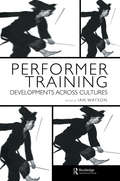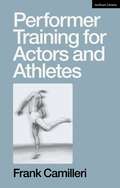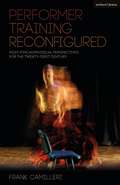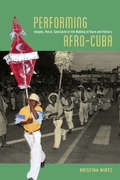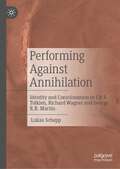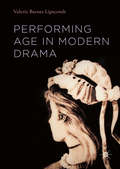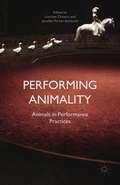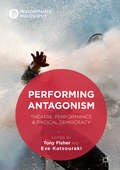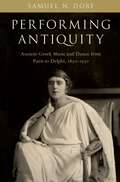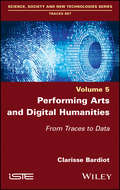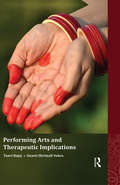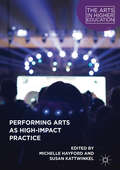- Table View
- List View
The Performer: Art, Life, Politics
by Richard SennettAn acclaimed sociologist’s exploration of the connections among performances in life, art, and politics In The Performer, Richard Sennett explores the relations between performing in art (particularly music), politics, and everyday experience. It focuses on the bodily and physical dimensions of performing, rather than on words. Sennett is particularly attuned to the ways in which the rituals of ordinary life are performances. The book draws on history and sociology, and more personally on the author’s early career as a professional cellist, as well as on his later work as a city planner and social thinker. It traces the evolution of performing spaces in the city; the emergence of actors, musicians, and dancers as independent artists; the inequality between performer and spectator; the uneasy relations between artistic creation and social and religious ritual; the uses and abuses of acting by politicians. The Janus-faced art of performing is both destructive and civilizing.
Performer Training: Developments Across Cultures
by Ian WatsonPerformer Training is an examination of how actors are trained in different cultures. Beginning with studies of mainstream training in countries such as Poland, Australia, Germany, and the United States, subsequent studies survey: · Some of Asia's traditional training methods and recent experiments in performer training · Eugenio Barba's training methods · Jerzy Grotowski's most recent investigations · The Japanese American NOHO companies attempts at integrating Kyogen into the works of Samuel Beckett · Descriptions of the training methods developed by Tadashi Suzuki and Anne Bogart at their Saratoga International Theatre Institute · Recent efforts to re-examine the role and scope of training, like Britain's International Workshop Festival and the European League of Institutes of Arts masterclasses · The reformulation of the use of emotions in performer training known as Alba Emoting.
Performer Training: Developments Across Cultures (Contemporary Theatre Studies #Vol. 38)
by Ian WatsonPerformer Training is an examination of how actors are trained in different cultures. Beginning with studies of mainstream training in countries such as Poland, Australia, Germany, and the United States, subsequent studies survey: · Some of Asia's traditional training methods and recent experiments in performer training · Eugenio Barba's training methods · Jerzy Grotowski's most recent investigations · The Japanese American NOHO companies attempts at integrating Kyogen into the works of Samuel Beckett · Descriptions of the training methods developed by Tadashi Suzuki and Anne Bogart at their Saratoga International Theatre Institute · Recent efforts to re-examine the role and scope of training, like Britain's International Workshop Festival and the European League of Institutes of Arts masterclasses · The reformulation of the use of emotions in performer training known as Alba Emoting.
Performer Training for Actors and Athletes
by Frank CamilleriWhat goes on in the body and mind of an endurance athlete at the limits of performance? How do they relate to the world around and prepare for the task ahead? Offering a refreshing perspective on training in the cross-lighting of aesthetic and athletic processes, this book focuses on the learning, mastery and creative adaptation of technique in performance. From traditional and physical actors to runners, boxers and other sports practitioners, it is about performers: their bodies, trainings and experiences. It interrogates what it means to prepare and train as a performer in the early 21st century.Writing from extensive experience in physical theatre and long-distance running, the author combines insights from both disciplines along with theatre history, sports science and perspectives like embodied cognition and affective science. From the kind of thoughts that go through the mind of an actor or a runner, to the economy and aesthetic of their movement and to how they feel about it, this book sheds light on the performing body and its capacities for action.Topics covered include attentional focus and distraction, affordances and equipment, 'choking' and stage fright, physiological regulation and effort perception, pacing and play, optimal flow and creative improvisation, and intentionality and automaticity in expert performance. The volume presents an informative and thought-provoking account accessible to readers interested in theatre, dance, performance, running, athletics, and sport.
Performer Training for Actors and Athletes
by Frank CamilleriWhat goes on in the body and mind of an endurance athlete at the limits of performance? How do they relate to the world around and prepare for the task ahead? Offering a refreshing perspective on training in the cross-lighting of aesthetic and athletic processes, this book focuses on the learning, mastery and creative adaptation of technique in performance. From traditional and physical actors to runners, boxers and other sports practitioners, it is about performers: their bodies, trainings and experiences. It interrogates what it means to prepare and train as a performer in the early 21st century.Writing from extensive experience in physical theatre and long-distance running, the author combines insights from both disciplines along with theatre history, sports science and perspectives like embodied cognition and affective science. From the kind of thoughts that go through the mind of an actor or a runner, to the economy and aesthetic of their movement and to how they feel about it, this book sheds light on the performing body and its capacities for action.Topics covered include attentional focus and distraction, affordances and equipment, 'choking' and stage fright, physiological regulation and effort perception, pacing and play, optimal flow and creative improvisation, and intentionality and automaticity in expert performance. The volume presents an informative and thought-provoking account accessible to readers interested in theatre, dance, performance, running, athletics, and sport.
Performer Training Reconfigured: Post-psychophysical Perspectives for the Twenty-first Century (Performance Books)
by Frank CamilleriOffering a radical re-evaluation of current approaches to performer training, this is a text that equips readers with a set of new ways of thinking about and ultimately 'doing' training. Stemming from his extensive practice and incorporating a review of prevailing methods and theories, Frank Camilleri focuses on how material circumstances shape and affect processes of training, devising, rehearsing and performing. Frank Camilleri puts forward the 'post-psychophysical' as a more extended form of psychophysical discussion and practice that emerged and dominated in the 20th century. The 'post-psychophysical' updates the concept of an integrated bodymind in various ways, such as the notion of a performer's bodyworld that incorporates technology and the material world. Offering invaluable introductions to a wide range of theories around which the book is structured – including postphenomenological, sociomaterial, affect and situated cognition – this volume provides readers with an enticing array of critical approaches to training and creative processes.
Performer Training Reconfigured: Post-psychophysical Perspectives for the Twenty-first Century (Performance Books)
by Frank CamilleriOffering a radical re-evaluation of current approaches to performer training, this is a text that equips readers with a set of new ways of thinking about and ultimately 'doing' training. Stemming from his extensive practice and incorporating a review of prevailing methods and theories, Frank Camilleri focuses on how material circumstances shape and affect processes of training, devising, rehearsing and performing. Frank Camilleri puts forward the 'post-psychophysical' as a more extended form of psychophysical discussion and practice that emerged and dominated in the 20th century. The 'post-psychophysical' updates the concept of an integrated bodymind in various ways, such as the notion of a performer's bodyworld that incorporates technology and the material world. Offering invaluable introductions to a wide range of theories around which the book is structured – including postphenomenological, sociomaterial, affect and situated cognition – this volume provides readers with an enticing array of critical approaches to training and creative processes.
The Performer's Tale: The Nine Lives of Patience Collier
by Vanessa MortonA vivid and compelling biography of Patience Collier – an actress whose career spanned a golden age of performance from the 1930s to the 1980s – and an overview of theatre, film, TV and radio in Britain over half a century.Though Patience Collier's name has faded from public consciousness since her death in 1987, it still conjures cool memories of iconic television and film from the 1970s and 1980s – Sapphire and Steel, Who Pays the Ferryman, Fiddler on the Roof and The French Lieutenant's Woman. Fearsome, eccentric and unpredictable, Patience Collier was an actress whose perfectionism shone through in her every performance, and who worked alongside many of the most celebrated actors and directors of her time.Drawing on Collier's diaries, letters and photographs as well as interviews with those who worked with her, Vanessa Morton paints a portrait of a gifted and eccentric woman weaving her way through the twentieth century, and gives a panoramic overview of theatre, film, TV and radio in Britain over half a century. Part social history, part cultural history, The Performer's Tale is a richly entertaining account of an actor's life and times.'I never met Patience Collier. Now, having read Vanessa Morton's richly entertaining book, I feel as if I did' Michael Billington, former theatre critic of the Guardian
Performing Afro-Cuba: Image, Voice, Spectacle in the Making of Race and History
by Kristina WirtzVisitors to Cuba will notice that Afro-Cuban figures and references are everywhere: in popular music and folklore shows, paintings and dolls of Santería saints in airport shops, and even restaurants with plantation themes. In Performing Afro-Cuba, Kristina Wirtz examines how the animation of Cuba’s colonial past and African heritage through such figures and performances not only reflects but also shapes the Cuban experience of Blackness. She also investigates how this process operates at different spatial and temporal scales—from the immediate present to the imagined past, from the barrio to the socialist state. Wirtz analyzes a variety of performances and the ways they construct Cuban racial and historical imaginations. She offers a sophisticated view of performance as enacting diverse revolutionary ideals, religious notions, and racial identity politics, and she outlines how these concepts play out in the ongoing institutionalization of folklore as an official, even state-sponsored, category. Employing Bakhtin’s concept of “chronotopes”—the semiotic construction of space-time—she examines the roles of voice, temporality, embodiment, imagery, and memory in the racializing process. The result is a deftly balanced study that marries racial studies, performance studies, anthropology, and semiotics to explore the nature of race as a cultural sign, one that is always in process, always shifting.
Performing Afro-Cuba: Image, Voice, Spectacle in the Making of Race and History
by Kristina WirtzVisitors to Cuba will notice that Afro-Cuban figures and references are everywhere: in popular music and folklore shows, paintings and dolls of Santería saints in airport shops, and even restaurants with plantation themes. In Performing Afro-Cuba, Kristina Wirtz examines how the animation of Cuba’s colonial past and African heritage through such figures and performances not only reflects but also shapes the Cuban experience of Blackness. She also investigates how this process operates at different spatial and temporal scales—from the immediate present to the imagined past, from the barrio to the socialist state. Wirtz analyzes a variety of performances and the ways they construct Cuban racial and historical imaginations. She offers a sophisticated view of performance as enacting diverse revolutionary ideals, religious notions, and racial identity politics, and she outlines how these concepts play out in the ongoing institutionalization of folklore as an official, even state-sponsored, category. Employing Bakhtin’s concept of “chronotopes”—the semiotic construction of space-time—she examines the roles of voice, temporality, embodiment, imagery, and memory in the racializing process. The result is a deftly balanced study that marries racial studies, performance studies, anthropology, and semiotics to explore the nature of race as a cultural sign, one that is always in process, always shifting.
Performing Afro-Cuba: Image, Voice, Spectacle in the Making of Race and History
by Kristina WirtzVisitors to Cuba will notice that Afro-Cuban figures and references are everywhere: in popular music and folklore shows, paintings and dolls of Santería saints in airport shops, and even restaurants with plantation themes. In Performing Afro-Cuba, Kristina Wirtz examines how the animation of Cuba’s colonial past and African heritage through such figures and performances not only reflects but also shapes the Cuban experience of Blackness. She also investigates how this process operates at different spatial and temporal scales—from the immediate present to the imagined past, from the barrio to the socialist state. Wirtz analyzes a variety of performances and the ways they construct Cuban racial and historical imaginations. She offers a sophisticated view of performance as enacting diverse revolutionary ideals, religious notions, and racial identity politics, and she outlines how these concepts play out in the ongoing institutionalization of folklore as an official, even state-sponsored, category. Employing Bakhtin’s concept of “chronotopes”—the semiotic construction of space-time—she examines the roles of voice, temporality, embodiment, imagery, and memory in the racializing process. The result is a deftly balanced study that marries racial studies, performance studies, anthropology, and semiotics to explore the nature of race as a cultural sign, one that is always in process, always shifting.
Performing Afro-Cuba: Image, Voice, Spectacle in the Making of Race and History
by Kristina WirtzVisitors to Cuba will notice that Afro-Cuban figures and references are everywhere: in popular music and folklore shows, paintings and dolls of Santería saints in airport shops, and even restaurants with plantation themes. In Performing Afro-Cuba, Kristina Wirtz examines how the animation of Cuba’s colonial past and African heritage through such figures and performances not only reflects but also shapes the Cuban experience of Blackness. She also investigates how this process operates at different spatial and temporal scales—from the immediate present to the imagined past, from the barrio to the socialist state. Wirtz analyzes a variety of performances and the ways they construct Cuban racial and historical imaginations. She offers a sophisticated view of performance as enacting diverse revolutionary ideals, religious notions, and racial identity politics, and she outlines how these concepts play out in the ongoing institutionalization of folklore as an official, even state-sponsored, category. Employing Bakhtin’s concept of “chronotopes”—the semiotic construction of space-time—she examines the roles of voice, temporality, embodiment, imagery, and memory in the racializing process. The result is a deftly balanced study that marries racial studies, performance studies, anthropology, and semiotics to explore the nature of race as a cultural sign, one that is always in process, always shifting.
Performing Afro-Cuba: Image, Voice, Spectacle in the Making of Race and History
by Kristina WirtzVisitors to Cuba will notice that Afro-Cuban figures and references are everywhere: in popular music and folklore shows, paintings and dolls of Santería saints in airport shops, and even restaurants with plantation themes. In Performing Afro-Cuba, Kristina Wirtz examines how the animation of Cuba’s colonial past and African heritage through such figures and performances not only reflects but also shapes the Cuban experience of Blackness. She also investigates how this process operates at different spatial and temporal scales—from the immediate present to the imagined past, from the barrio to the socialist state. Wirtz analyzes a variety of performances and the ways they construct Cuban racial and historical imaginations. She offers a sophisticated view of performance as enacting diverse revolutionary ideals, religious notions, and racial identity politics, and she outlines how these concepts play out in the ongoing institutionalization of folklore as an official, even state-sponsored, category. Employing Bakhtin’s concept of “chronotopes”—the semiotic construction of space-time—she examines the roles of voice, temporality, embodiment, imagery, and memory in the racializing process. The result is a deftly balanced study that marries racial studies, performance studies, anthropology, and semiotics to explore the nature of race as a cultural sign, one that is always in process, always shifting.
Performing Afro-Cuba: Image, Voice, Spectacle in the Making of Race and History
by Kristina WirtzVisitors to Cuba will notice that Afro-Cuban figures and references are everywhere: in popular music and folklore shows, paintings and dolls of Santería saints in airport shops, and even restaurants with plantation themes. In Performing Afro-Cuba, Kristina Wirtz examines how the animation of Cuba’s colonial past and African heritage through such figures and performances not only reflects but also shapes the Cuban experience of Blackness. She also investigates how this process operates at different spatial and temporal scales—from the immediate present to the imagined past, from the barrio to the socialist state. Wirtz analyzes a variety of performances and the ways they construct Cuban racial and historical imaginations. She offers a sophisticated view of performance as enacting diverse revolutionary ideals, religious notions, and racial identity politics, and she outlines how these concepts play out in the ongoing institutionalization of folklore as an official, even state-sponsored, category. Employing Bakhtin’s concept of “chronotopes”—the semiotic construction of space-time—she examines the roles of voice, temporality, embodiment, imagery, and memory in the racializing process. The result is a deftly balanced study that marries racial studies, performance studies, anthropology, and semiotics to explore the nature of race as a cultural sign, one that is always in process, always shifting.
Performing Against Annihilation: Identity and Consciousness in J.R.R. Tolkien, Richard Wagner and George R.R. Martin
by Lukas ScheppThis book outlines how the protagonists in The Nibelung's Ring, The Lord of the Rings, and Game of Thrones attempt to construct identities and expand their consciousness manifestations. As the characters in the three works face the ends of their respective worlds, they must find answers to their mortality, and to the threat it implies: the loss of identity and consciousness. Moreover, it details how this process is depicted performatively. In a hands-on and interdisciplinary approach, this book seeks to unveil the underlying philosophical concepts of identity and consciousness in the three works as they are represented audio-visually on stage and screen. Through the use of many practical examples, this book offers both academic scholars and any interested readers a completely new perspective on three enduringly popular and interrelated works.
Performing Age in Modern Drama
by Valerie Barnes LipscombThis book is the first to examine age across the modern and contemporary dramatic canon, from Arthur Miller and Tennessee Williams to Paula Vogel and Doug Wright. All ages across the life course are interpreted as performance and performative both on page and on stage, including professional productions and senior-theatre groups.The common admonition "act your age" provides the springboard for this study, which rests on the premise that age is performative in nature, and that issues of age and performance crystallize in the theatre.Dramatic conventions include characters who change ages from one moment to the next, overtly demonstrating on stage the reiterated actions that create a performative illusion of stable age. Moreover, directors regularly cast actors in these plays against their chronological ages. Lipscomb contends that while the plays reflect varying attitudes toward performing age, as a whole they reveal a longing for an ageless self, a desire to present a consistent, unified identity. The works mirror prevailing social perceptions of the aging process as well as the tension between chronological age, physiological age, and cultural constructions of age.
Performing Animality: Animals in Performance Practices
by Jennifer Parker-StarbuckPerforming Animality provides theoretical and creative interventions into the presence of the animal and ideas of animality in performance. Animals have always played a part in human performance practices. Maintaining a crucial role in many communities' cultural traditions, animal-human encounters have been key in the development of performance. Similarly, performance including both living animals and/or representations of animals provides the context for encounters in which issues of power, human subjectivity and otherness are explored. Crucially, however, the inclusion of animals in performance also offers an opportunity to investigate ethical and moral assumptions about human and non-human animals. This book offers a historical and theoretical exploration of animal presence in performance by looking at the concept of animality and how it has developed in theatre and performance practices from the eighteenth century to today. Furthermore, it points to shifts in political, cultural, and ethical animal-human relations emerging within the context of animality and performance.
Performing Antagonism: Theatre, Performance & Radical Democracy (Performance Philosophy)
by Tony Fisher Eve KatsourakiThis book combines performance analysis with contemporary political philosophy to advance new ways of understanding both political performance and the performativity of the politics of the street.Our times are pre-eminently political times and have drawn radical responses from many theatre and performance practitioners. However, a decade of conflict in the Middle East and Afghanistan, the eruption of new social movements around the world, the growth of anti-capitalist and anti-globalisation struggles, the upsurge of protests against the blockades of neoliberalism, and the rising tide of dissent and anger against corporate power, with its exorbitant social costs, have left theatre and performance scholarship confronting something of a dilemma: how to theorize the political antagonisms of our day? Drawing on the resources of ‘post-Marxist’ political thinkers such as Chantal Mouffe and Jacques Rancière, the book explores how new theoretical horizons have been made available for performance analysis.
Performing Antiquity: Ancient Greek Music and Dance from Paris to Delphi, 1890-1930
by Samuel N. DorfPerforming Antiquity: Ancient Greek Music and Dance from Paris to Delphi, 1890-1930 investigates collaborations between French and American scholars of Greek antiquity (archaeologists, philologists, classicists, and musicologists), and the performing artists (dancers, composers, choreographers and musicians) who brought their research to life at the birth of Modernism. The book tells the story of performances taking place at academic conferences, the Paris Opéra, ancient amphitheaters in Delphi, and private homes. These musical and dance collaborations are built on reciprocity: the performers gain new insight into their craft while learning new techniques or repertoire and the scholars gain an opportunity to bring theory into experimental practice, that is, they have a chance see/hear/experience what they have studied and imagined. The performers receive the imprimatur of scholarship, the stamp of authenticity, and validation for their creative activities. Drawing from methods and theory from musicology, dance studies, performance studies, queer studies, archaeology, classics and art history the book shows how new scholarly methods and technologies altered the performance, and, ultimately, the reception of music and dance of the past. Acknowledging and critically examining the complex relationships performers and scholars had with the pasts they studied does not undermine their work. Rather, understanding our own limits, biases, dreams, obsessions, desires, loves, and fears enriches the ways we perform the past.
Performing Antiquity: Ancient Greek Music and Dance from Paris to Delphi, 1890-1930
by Samuel N. DorfPerforming Antiquity: Ancient Greek Music and Dance from Paris to Delphi, 1890-1930 investigates collaborations between French and American scholars of Greek antiquity (archaeologists, philologists, classicists, and musicologists), and the performing artists (dancers, composers, choreographers and musicians) who brought their research to life at the birth of Modernism. The book tells the story of performances taking place at academic conferences, the Paris Opéra, ancient amphitheaters in Delphi, and private homes. These musical and dance collaborations are built on reciprocity: the performers gain new insight into their craft while learning new techniques or repertoire and the scholars gain an opportunity to bring theory into experimental practice, that is, they have a chance see/hear/experience what they have studied and imagined. The performers receive the imprimatur of scholarship, the stamp of authenticity, and validation for their creative activities. Drawing from methods and theory from musicology, dance studies, performance studies, queer studies, archaeology, classics and art history the book shows how new scholarly methods and technologies altered the performance, and, ultimately, the reception of music and dance of the past. Acknowledging and critically examining the complex relationships performers and scholars had with the pasts they studied does not undermine their work. Rather, understanding our own limits, biases, dreams, obsessions, desires, loves, and fears enriches the ways we perform the past.
Performing Arts and Digital Humanities: From Traces to Data
by Clarisse BardiotDigital traces, whether digitized (programs, notebooks, drawings, etc.) or born digital (emails, websites, video recordings, etc.), constitute a major challenge for the memory of the ephemeral performing arts.Digital technology transforms traces into data and, in doing so, opens them up to manipulation. This paradigm shift calls for a renewal of methodologies for writing the history of theater today, analyzing works and their creative process, and preserving performances. At the crossroads of performing arts studies, the history, digital humanities, conservation and archiving, these methodologies allow us to take into account what is generally dismissed, namely, digital traces that are considered too complex, too numerous, too fragile, of dubious authenticity, etc.With the analysis of Merce Cunningham’s digital traces as a guideline, and through many other examples, this book is intended for researchers and archivists, as well as artists and cultural institutions.
Performing Arts and Digital Humanities: From Traces to Data
by Clarisse BardiotDigital traces, whether digitized (programs, notebooks, drawings, etc.) or born digital (emails, websites, video recordings, etc.), constitute a major challenge for the memory of the ephemeral performing arts.Digital technology transforms traces into data and, in doing so, opens them up to manipulation. This paradigm shift calls for a renewal of methodologies for writing the history of theater today, analyzing works and their creative process, and preserving performances. At the crossroads of performing arts studies, the history, digital humanities, conservation and archiving, these methodologies allow us to take into account what is generally dismissed, namely, digital traces that are considered too complex, too numerous, too fragile, of dubious authenticity, etc.With the analysis of Merce Cunningham’s digital traces as a guideline, and through many other examples, this book is intended for researchers and archivists, as well as artists and cultural institutions.
Performing Arts and Therapeutic Implications
by Tanvi Bajaj Swasti Shrimali VohraPresenting an alternative perspective, this book proposes that performing arts forge an emotional bond between the performer and the audience, making the act of performance a therapeutic and restorative experience, and not merely recreational. Studying the life-experiences of six artists, and their unique engagement with three art forms — music, drama and dance — the book highlights the physical, emotional, mental, and spiritual effects of performing arts both on the performers and the audience. More importantly, it takes the current understanding of the therapeutic role of arts beyond a deficit model of health that focuses on their use in curing illnesses, disabilities and imbalances, towards a more positive growth-centric model that relates them to promoting holistic mental health, well-being and happiness. It thus bridges the gap between the theoretical understanding of creative arts therapy and the practical experience of performing arts in non-therapeutic settings. Further, it assumes increasing relevance with respect to fast-changing lifestyles to which stress and ill-health are often attributed. The book will appeal to artists, educators and researchers of performing arts, applied psychology, counselling and therapy, and cultural studies, as well as interested general readers.
Performing Arts and Therapeutic Implications
by Tanvi Bajaj Swasti Shrimali VohraPresenting an alternative perspective, this book proposes that performing arts forge an emotional bond between the performer and the audience, making the act of performance a therapeutic and restorative experience, and not merely recreational. Studying the life-experiences of six artists, and their unique engagement with three art forms — music, drama and dance — the book highlights the physical, emotional, mental, and spiritual effects of performing arts both on the performers and the audience. More importantly, it takes the current understanding of the therapeutic role of arts beyond a deficit model of health that focuses on their use in curing illnesses, disabilities and imbalances, towards a more positive growth-centric model that relates them to promoting holistic mental health, well-being and happiness. It thus bridges the gap between the theoretical understanding of creative arts therapy and the practical experience of performing arts in non-therapeutic settings. Further, it assumes increasing relevance with respect to fast-changing lifestyles to which stress and ill-health are often attributed. The book will appeal to artists, educators and researchers of performing arts, applied psychology, counselling and therapy, and cultural studies, as well as interested general readers.
Performing Arts as High-Impact Practice (The\arts In Higher Education Ser.)
by Michelle Hayford Susan KattwinkelThis book investigates how the performing arts in higher education nationally contribute to the “high impact practices,” as identified by the Association of American Colleges and Universities (AACU). Using the well-known map of the HIPs for illustrating the centrality of performing arts practices in higher education, the editors and authors of this volume call for increased participation by performing arts programs in general education and campus initiatives, with specific case studies as a guide. Performing arts contribute to the efforts of their institution in delivering a strong liberal arts education that uniquely serves students to meet the careers of the future. This is the first book to explicitly link the performing arts to the HIPs, and will result in the implementation of best practices to better meet the educational needs of students. At stake is the viability of performing arts programs to continue to serve students in their pursuit of a liberal arts education.
